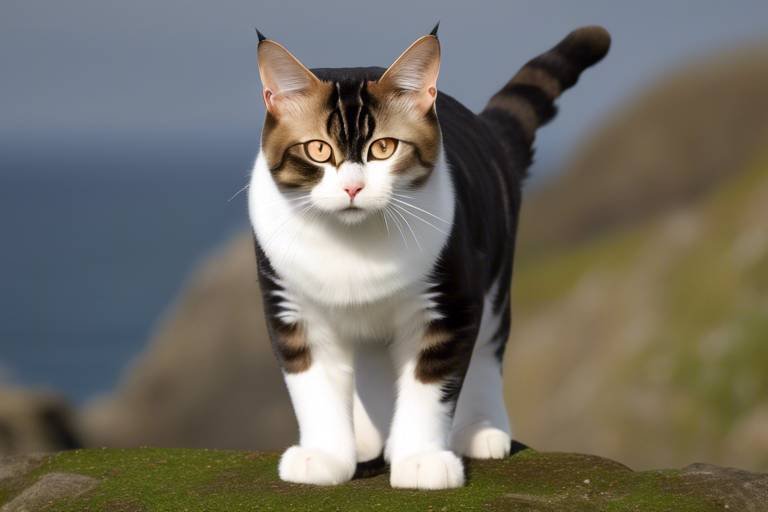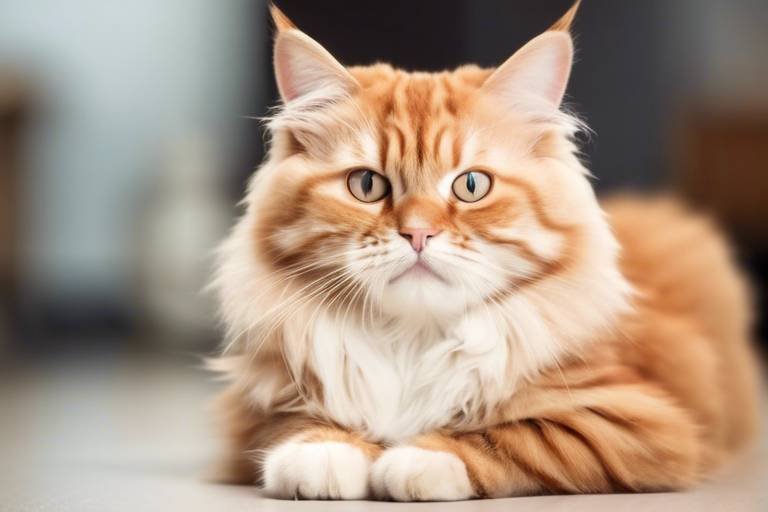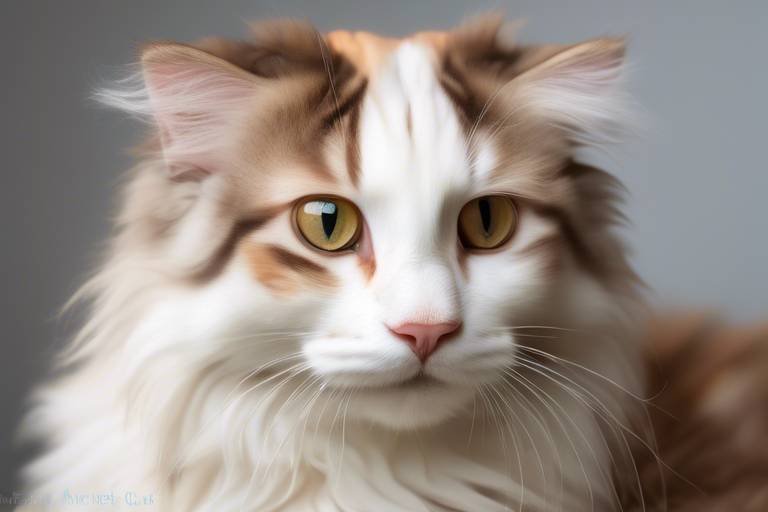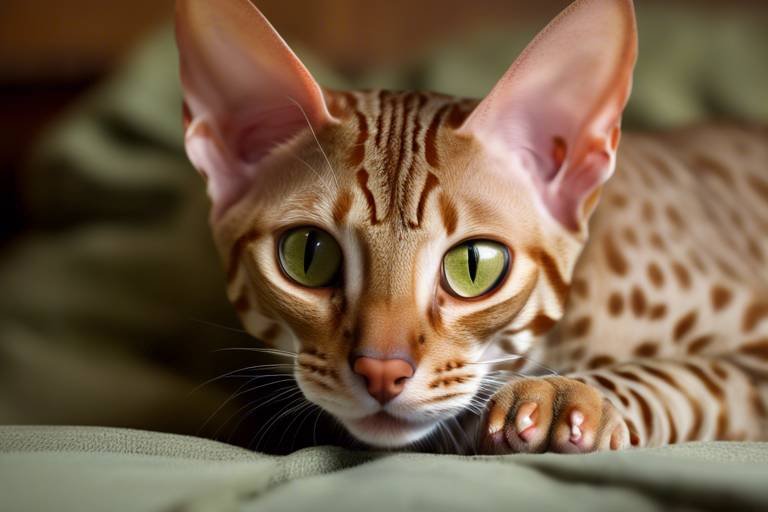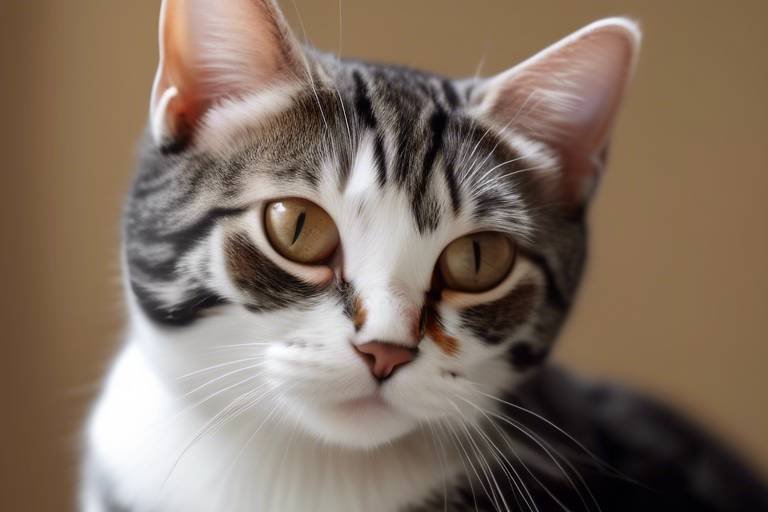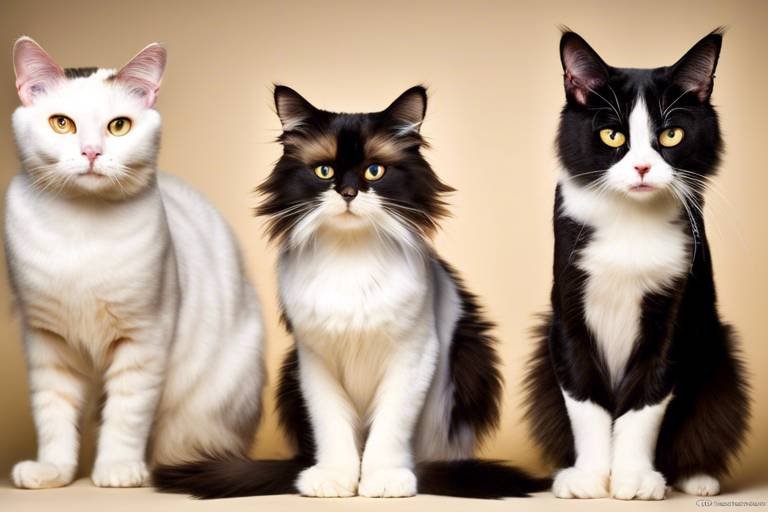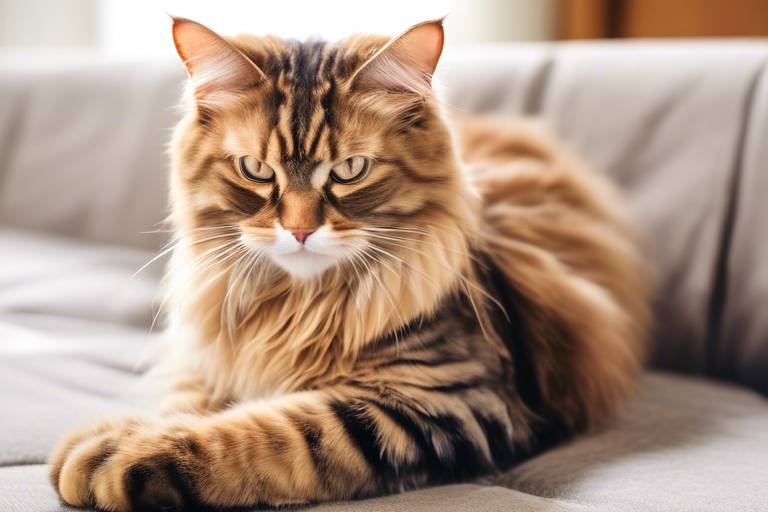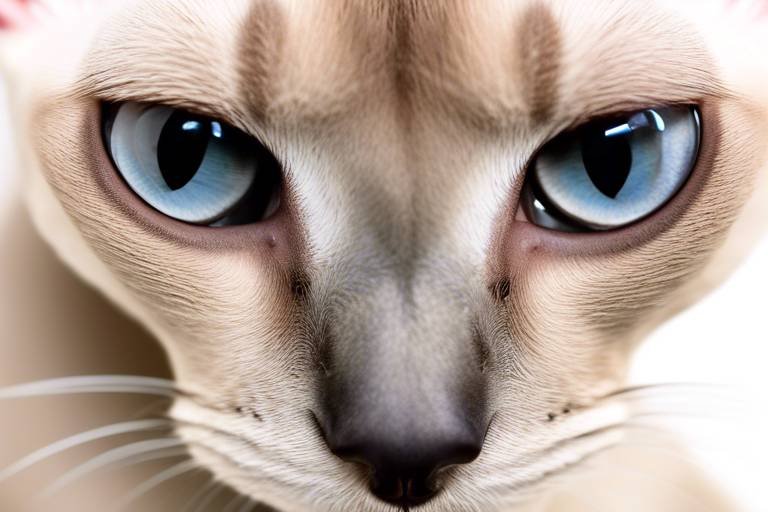Understanding the Personality of the Burmese Cat
Burmese cats are not just pets; they are affectionate companions that bring warmth and joy into the lives of those who are lucky enough to share their homes with them. With their striking appearance, characterized by a sleek, muscular body and large, expressive eyes, these cats are as charming as they are loving. But what truly sets them apart is their unique personality. If you've ever been captivated by a Burmese cat's playful antics or their deep, soulful gaze, you know that there’s something special about them. In this article, we will explore the various traits that make Burmese cats such beloved companions, from their affectionate nature to their intelligence and social tendencies.
Burmese cats are renowned for their affectionate nature. Unlike some cats that prefer solitude, Burmese cats thrive on human interaction. They are often described as "people-oriented" because they actively seek out companionship and affection. You might find your Burmese cat curled up in your lap, following you from room to room, or even giving you gentle nudges with their head as a way of saying, "Hey, I’m here!" This behavior is not just adorable; it’s a testament to their deep bond with their owners. They are known to form strong attachments, often showing signs of anxiety when left alone for extended periods. This need for closeness makes them perfect companions for those who enjoy a loving and interactive pet.
When it comes to intelligence, Burmese cats are in a league of their own. They are not only affectionate but also highly intelligent, which makes them incredibly engaging pets. Their playful behavior is a joy to witness; they love to chase after toys, solve puzzles, and engage in interactive play with their owners. In fact, their problem-solving abilities can sometimes leave us humans in awe! Burmese cats are known to figure out how to open doors or cabinets, showcasing their cleverness. Engaging them with a variety of toys and activities is essential, as it keeps their minds sharp and their spirits high. So, whether it’s a feather wand, a laser pointer, or a simple cardboard box, be prepared for hours of fun!
Social creatures by nature, Burmese cats thrive on interaction—not just with their human companions but also with other pets. Their sociable disposition makes them excellent additions to multi-pet households. They often get along well with dogs and other cats, displaying a friendly demeanor that is hard to resist. However, it’s important to introduce them gradually to new pets to ensure everyone feels comfortable. Their need for companionship means they often seek out the company of others, making them less suited for homes where they might be left alone for long periods. After all, who wouldn’t want to have a furry friend by their side?
The bond between a Burmese cat and its owner is something truly special. These cats express their love in unique ways—whether it’s through gentle purring, head-butting, or even following you around the house. They have a knack for knowing when you need a little extra love, often curling up next to you during quiet moments. Their loyalty is unwavering, and they thrive on the attention and affection they receive from their humans. This connection fosters a deep sense of trust and companionship that is hard to replicate.
When it comes to integrating a Burmese cat into a multi-pet household, patience is key. Their friendly nature generally makes them adaptable, but it’s important to introduce them to other animals slowly. Here are some tips to ensure a smooth transition:
- Start with short, supervised interactions.
- Provide separate spaces for each pet to retreat to.
- Reward positive interactions with treats and praise.
- Be patient and allow them to adjust at their own pace.
With time and proper introductions, Burmese cats can form delightful friendships with other pets, enriching the household dynamic.
One of the most fascinating aspects of Burmese cats is their vocalization. These cats are known for their distinct and melodious sounds, which they use to communicate their needs and desires. Whether it's a gentle meow to get your attention or a loud call when they want to play, their vocalizations are a big part of their personality. They are not shy about expressing themselves, and their vocal nature can often lead to amusing conversations between you and your feline friend. Listening to a Burmese cat is like having a chatty companion who always has something to say!
Understanding the activity level of Burmese cats is crucial to ensuring their well-being. These cats are energetic and require regular playtime to stay healthy and happy. A bored Burmese cat can become mischievous, so it’s essential to provide them with ample opportunities for exercise. Regular play sessions not only help burn off excess energy but also strengthen the bond between you and your pet. Incorporating a variety of activities into their routine can keep them engaged and satisfied.
To keep your Burmese cat entertained, consider these ideal playtime activities:
- Interactive toys that challenge their intelligence.
- Feather wands for engaging their hunting instincts.
- Laser pointers to encourage chasing and jumping.
- Cat trees for climbing and exploring.
These activities will not only keep them physically active but also mentally stimulated, ensuring they remain healthy and happy.
Creating a stimulating environment is vital for a Burmese cat's well-being. These cats are curious and inquisitive, and they thrive in spaces that cater to their adventurous nature. Consider adding climbing structures, scratching posts, and interactive toys throughout your home. A window perch can also provide entertainment as they watch the world go by. Enriching their environment will help satisfy their playful instincts and keep them from becoming bored or anxious.
Q: How can I tell if my Burmese cat is happy?
A: A happy Burmese cat will exhibit playful behavior, seek your attention, and maintain a relaxed posture. Purring and kneading are also good signs of contentment.
Q: Do Burmese cats get along with children?
A: Yes, Burmese cats are generally gentle and affectionate, making them great companions for children. However, it's essential to supervise interactions to ensure both the cat and child feel safe.
Q: How much exercise do Burmese cats need?
A: Burmese cats require daily playtime and exercise. Aim for at least 30 minutes of active play each day to keep them healthy and happy.

Affectionate Nature
Burmese cats are truly a delight when it comes to their affectionate nature. These charming felines are known for their strong bond with humans, often exhibiting a level of devotion that can leave any cat lover in awe. Imagine coming home after a long day and being greeted by a furry friend who seems to have missed you just as much as you missed them! Burmese cats thrive on companionship and are always ready to shower their owners with love and attention.
One of the most remarkable traits of Burmese cats is their tendency to follow their humans around the house. They don’t just want to be in the same room; they want to be right beside you, whether you’re cooking dinner or lounging on the couch. This constant companionship can make you feel like you have a little shadow, always eager to join in on your activities. Their affectionate demeanor is not just limited to their humans; they often extend this warmth to other pets in the household, making them an ideal choice for families.
In everyday interactions, Burmese cats express their affection in various ways. From gentle headbutts and soft purring to curling up in your lap, these cats have a unique language of love. They are known to be extremely vocal, using their melodious voices to communicate their desires and feelings. You might find them meowing softly when they want attention, or even engaging in a playful conversation with you! Their vocalizations are not just sounds; they are a way for them to express their emotions and deepen their bond with you.
Moreover, Burmese cats have a knack for sensing their owner's mood. They can be incredibly intuitive, often curling up next to you when you’re feeling down or stressed. This ability to be there for you during tough times is what makes them such wonderful companions. It's almost as if they have a sixth sense, knowing exactly when you need a little extra love. Their affectionate nature makes them not just pets, but true members of the family.
To summarize, the affectionate nature of Burmese cats is a blend of their need for companionship, their expressive communication, and their intuitive understanding of human emotions. If you're looking for a pet that will shower you with love and never leave your side, a Burmese cat might just be the perfect addition to your home!

Intelligence and Playfulness
Burmese cats are not just your average feline companions; they possess a remarkable level of intelligence that often surprises their owners. These cats are known for their ability to learn quickly and adapt to new situations with ease. Whether it's mastering a new trick or figuring out how to open a door, their cleverness shines through in various ways. You might find yourself in awe as your Burmese cat seems to outsmart you during playtime, making them not only delightful but also engaging pets.
One of the standout traits of Burmese cats is their playfulness. They have a playful spirit that remains with them well into adulthood, making them lively companions. Unlike some other breeds that may calm down as they age, Burmese cats often retain their youthful energy, which can be a joy to witness. Imagine coming home after a long day and being greeted by a furry friend who is ready to play and explore! This playful nature is not just for show; it serves as a vital outlet for their intelligence.
Engaging your Burmese cat in play is essential for their mental stimulation. They thrive on interactive toys that challenge their problem-solving skills. For instance, toys that require them to figure out how to obtain a treat inside can keep them entertained for hours. Additionally, you might want to consider investing in a few puzzle toys or even creating DIY challenges at home. Here are some ideas:
- Interactive treat dispensers that require pawing or nudging.
- Feather wands that mimic the movements of prey.
- Laser pointers that encourage them to chase and pounce.
Furthermore, their intelligence allows them to engage in more complex games, such as fetch. Yes, you read that right! Some Burmese cats enjoy playing fetch, bringing back toys just like a dog would. This unique behavior is a testament to their high energy levels and willingness to engage with their human companions. It’s a fun way to bond and exercise at the same time!
But don’t be fooled; while they are playful and intelligent, Burmese cats also have a knack for understanding their environment. They are observant creatures that notice the smallest changes in their surroundings. This awareness can lead to amusing antics, as they may try to investigate new items or changes in the home. Their curious nature is a delightful aspect of their personality, making every day an adventure.
In summary, the intelligence and playfulness of Burmese cats make them exceptional companions. Their ability to learn, coupled with their love for engaging play, ensures that life with a Burmese cat is never dull. So, if you’re considering adding one to your family, be prepared for a furry friend who will keep you on your toes and fill your home with joy!
Social Interactions
Burmese cats are not just pets; they are social butterflies that thrive on interaction. Imagine a cat that greets you at the door, weaving between your legs, purring loudly as if to say, “I’ve missed you!” This is the essence of a Burmese cat's social nature. They are incredibly affectionate and often form strong bonds with their human companions. Their need for social interaction is not just a quirk but a fundamental aspect of their personality. These felines are known to follow their owners around the house, always eager to be part of the action. They crave companionship and are happiest when they’re surrounded by their favorite humans.
But it’s not just humans that they adore. Burmese cats often get along well with other pets, making them ideal for multi-pet households. They have a friendly demeanor that allows them to adapt quickly to new furry friends. Whether it’s a dog, another cat, or even a rabbit, a Burmese cat will likely find a way to socialize and play. Their playful nature encourages them to engage in games and activities with other animals, which can be a delightful sight for any pet owner.
So, how do you ensure that your Burmese cat gets the social interaction it craves? Here are a few tips:
- Quality Time: Spend time daily playing and cuddling with your Burmese cat. They thrive on your attention!
- Introduce New Friends Gradually: When bringing another pet into the home, allow for a gradual introduction to avoid overwhelming them.
- Interactive Toys: Use toys that encourage play between pets to foster bonding.
By understanding their social needs, you can create an environment that allows your Burmese cat to flourish. They will reward you with their love, loyalty, and playful antics, making your home a lively and joyful place. After all, a happy Burmese is a social Burmese!
Q: Do Burmese cats get along with other pets?
A: Yes, Burmese cats are generally friendly and can adapt well to multi-pet households. They enjoy socializing with both humans and other animals.
Q: How can I help my Burmese cat feel more social?
A: Spend quality time with your cat, provide interactive toys, and consider adopting another pet to keep them company.
Q: Are Burmese cats vocal?
A: Yes, they are known for their distinct vocalizations and often use sounds to communicate their needs and feelings.
Bonding with Humans
The bond between a Burmese cat and its human is nothing short of extraordinary. These cats are renowned for their affectionate nature, and they often form deep connections with their owners. Unlike many other breeds, Burmese cats have an innate desire to be close to their human companions, often following them from room to room like a shadow. This is not merely a trait; it’s a testament to their loving demeanor. You might find them curling up in your lap or nuzzling against your leg, seeking warmth and comfort. This behavior is not just about physical closeness; it’s a way for them to express their love and loyalty.
One of the most fascinating aspects of bonding with a Burmese cat is how they communicate their needs and feelings. They have a unique way of expressing affection—through soft purrs, gentle head butts, and even playful nudges. When they look into your eyes, it’s as if they are saying, “I trust you.” This trust is built through consistent interaction, where they learn that their humans are their safe haven. In fact, many owners report that their Burmese cats seem to have an almost intuitive understanding of their emotions, often providing comfort during tough times.
Moreover, Burmese cats thrive on routine and shared activities. Engaging in playtime or simply spending quiet moments together can significantly enhance the bond between you and your feline friend. They enjoy interactive toys that allow them to play alongside you, turning simple moments into cherished memories. It’s like a dance where both partners must be in sync, creating a rhythm of love and companionship. Here are a few ways to strengthen your bond:
- Spend quality time together—play, cuddle, or just relax in each other’s company.
- Engage in training sessions; Burmese cats are intelligent and enjoy learning new tricks.
- Provide a variety of toys to stimulate their playful nature and encourage interaction.
In essence, the relationship you cultivate with your Burmese cat is a beautiful journey of mutual affection and understanding. As you nurture this bond, you’ll discover that your cat not only becomes a beloved pet but also a true companion who shares your joys and comforts you in your sorrows. This deep connection is what makes the Burmese cat a cherished member of many families, bringing warmth and happiness into their lives.
Q: How can I tell if my Burmese cat is happy?
A: Happy Burmese cats typically exhibit playful behavior, purring, and a relaxed body posture. They may also seek out your company and enjoy cuddling.
Q: Are Burmese cats good for families?
A: Yes! Burmese cats are known for their affectionate nature and sociable behavior, making them great companions for families with children and other pets.
Q: How can I strengthen my bond with my Burmese cat?
A: Spend quality time together through play, training, and cuddling. Consistent interaction is key to building a strong relationship.
Getting Along with Other Pets
Burmese cats are often celebrated for their friendly demeanor, making them a fantastic addition to multi-pet households. Their sociable nature allows them to adapt well to living with other animals, whether it's another cat, a dog, or even smaller pets like rabbits or guinea pigs. One of the key traits that enable Burmese cats to coexist harmoniously with other pets is their playful spirit. They thrive on interaction and are usually eager to engage in play, which can help foster bonds with their furry companions.
When introducing a Burmese cat to other pets, it’s essential to approach the situation with care and consideration. Start by allowing the animals to sniff each other from a distance, gradually bringing them closer as they become familiar with each other's scents. This slow introduction can help avoid any potential territorial disputes, which are common among animals. Additionally, providing plenty of separate spaces for each pet can help them feel secure and reduce any feelings of competition.
Another important aspect of their social adaptability is their curiosity. Burmese cats are known to be inquisitive, which means they may be more willing to investigate and interact with other pets than some other breeds. However, it’s crucial to supervise their interactions initially, especially if the other pets are larger or more dominant. Observing their behavior can help you gauge whether they are getting along or if they need more time apart.
In households with multiple pets, it’s also beneficial to ensure that each pet receives individual attention. Burmese cats, while social, still appreciate their special time with their human companions. This balance of attention can help mitigate jealousy and ensure that all pets feel valued. With patience and positive reinforcement, Burmese cats can become not just good companions for humans, but also cherished friends to other pets in the home.
- Do Burmese cats get along with dogs? Yes, Burmese cats can get along well with dogs, especially if they are introduced properly and given time to adjust to each other.
- How can I help my Burmese cat adjust to a new pet? Gradual introductions, supervised interactions, and ensuring both pets have their own space can help ease the adjustment.
- Are Burmese cats territorial? While they can be territorial, their friendly nature often helps them adapt to living with other pets.
- What should I do if my Burmese cat is aggressive towards another pet? It's essential to separate them immediately and consult with a veterinarian or animal behaviorist for guidance.
Vocalization and Communication
Burmese cats are truly unique when it comes to their vocalization and communication styles. Unlike many other cat breeds, they are known for their distinctive voices that can range from soft chirps to loud, demanding meows. This variety in sounds is not just for show; it serves as a vital part of how they interact with their human companions. Have you ever noticed how a Burmese cat seems to have a special sound for every situation? It's almost as if they have their own language!
One of the most fascinating aspects of Burmese vocalization is their ability to express their emotions through sound. For example, a soft, gentle purr can indicate contentment, while a more persistent meow may signal that they want attention or food. This cat breed is particularly known for being affectionate and vocal, often following their owners around the house, chatting away as if sharing the latest gossip. It's this engaging personality that makes them such beloved companions.
When it comes to communication, Burmese cats are not just about vocal sounds. They also use body language and facial expressions to convey their feelings. A cat that approaches you with a relaxed posture and slow blinking is showing affection and trust, while a puffed-up tail or flattened ears might indicate fear or aggression. Understanding these cues is crucial for building a strong relationship with your furry friend. Are you paying attention to their body language?
Interestingly, Burmese cats seem to have a knack for understanding human emotions too. They often respond to their owner's tone of voice and can sense when you're feeling down or stressed. In such moments, they might curl up beside you or let out a soothing purr, acting as a furry therapist. This deep bond is what sets them apart from many other breeds, making them incredibly intuitive companions.
In summary, the vocalization and communication style of Burmese cats is a delightful mix of sounds and signals that reflect their affectionate and intelligent nature. By paying close attention to their vocal tones and body language, you can foster a deeper connection with your Burmese cat, ensuring that both of you understand each other perfectly. So next time your cat meows at you, take a moment to listen and respond; you might just find that they have something important to say!
- Do Burmese cats talk a lot? Yes, Burmese cats are known for being quite vocal and enjoy "chatting" with their owners.
- How can I tell if my Burmese cat is happy? A happy Burmese cat will often purr, knead, and display relaxed body language.
- What should I do if my cat is meowing excessively? Excessive meowing can indicate boredom, hunger, or a need for attention. Make sure they have enough playtime and check their food and water supply.

Activity Level and Exercise Needs
Burmese cats are known for their high energy levels and playful demeanor, making it essential for owners to understand their exercise needs. These felines are not just couch potatoes; they thrive on activity and engagement. Imagine a lively little gymnast, always ready to leap and bound around the house! It's this vibrant personality that makes them such delightful companions. To keep your Burmese cat healthy and happy, regular playtime is not just a suggestion; it’s a necessity.
Typically, Burmese cats require at least 30 to 60 minutes of playtime each day. This can be broken up into several short sessions throughout the day. Engaging your cat in play helps to stimulate their minds and keep their bodies fit. Think of it as a workout session where both you and your furry friend can bond while burning off some of that excess energy. Whether it's chasing a feather toy or pouncing on a laser dot, these activities not only provide physical exercise but also encourage mental stimulation.
To give you an idea of how to structure your Burmese cat's playtime, here’s a simple table illustrating different activities:
| Activity | Duration | Benefits |
|---|---|---|
| Interactive Play (with toys) | 15-20 minutes | Enhances agility and coordination |
| Chasing Laser Pointer | 10-15 minutes | Stimulates hunting instincts |
| Climbing and Scratching | Varies | Strengthens muscles and keeps claws healthy |
| Puzzle Toys | 10-30 minutes | Encourages problem-solving and reduces boredom |
In addition to structured play, it's crucial to create an environment that encourages exploration and activity. Burmese cats are naturally curious and enjoy climbing and exploring their surroundings. You can enhance their living space by providing cat trees, shelves, and other vertical spaces where they can climb and perch. This not only satisfies their curiosity but also helps them develop their physical skills. Picture your Burmese cat scaling a tall cat tree, surveying their kingdom with pride!
Moreover, you might want to incorporate some outdoor time into their routine, if possible. Supervised outdoor play can provide fresh air and new experiences, but always ensure their safety. A harness and leash can be a great way to let them explore safely. Just imagine the thrill of watching your Burmese cat explore the great outdoors, sniffing new scents and soaking up the sun!
In summary, understanding the activity level and exercise needs of Burmese cats is fundamental to their well-being. By providing ample playtime, stimulating environments, and opportunities for exploration, you can ensure that your Burmese cat remains a happy and healthy member of your family. After all, a well-exercised cat is not only a healthier cat but also a more content and loving companion.
- How much exercise does a Burmese cat need daily? Burmese cats typically require 30 to 60 minutes of playtime each day.
- What are some good toys for Burmese cats? Interactive toys, feather wands, laser pointers, and puzzle toys are great for keeping them engaged.
- Can Burmese cats go outside? Yes, but they should be supervised and ideally on a harness and leash to ensure their safety.
- How can I tell if my Burmese cat is bored? Signs of boredom can include excessive meowing, destructive behavior, or a lack of interest in usual activities.
Ideal Playtime Activities
When it comes to keeping your Burmese cat happy and healthy, playtime is not just an option; it’s a necessity! These little bundles of energy thrive on stimulation and interaction, so providing them with ideal playtime activities is essential. Think of playtime as a workout session for your furry friend, where their mind and body get the exercise they need. So, what are some activities that can keep your Burmese cat engaged and entertained?
First off, one of the best ways to keep your Burmese cat active is through interactive toys. These can range from feather wands to laser pointers. Imagine your cat pouncing and leaping like a tiny tiger, chasing after that elusive red dot! Not only does this provide physical exercise, but it also engages their hunting instincts. When choosing toys, opt for those that mimic prey movements, as they are more likely to capture your cat's attention.
Another great option is puzzle toys. These toys challenge your cat’s intellect and problem-solving skills. Fill them with treats or kibble, and watch as your Burmese cat figures out how to retrieve the goodies. It’s like a mini treasure hunt! This not only keeps them occupied but also prevents boredom, which can lead to unwanted behaviors.
Don't forget about the importance of social play. Burmese cats are naturally social creatures, and they love to engage with their humans. Spend time playing fetch with a soft ball or engage in a game of hide and seek. You might be surprised at how quickly your Burmese cat picks up on these games. They enjoy the interaction and will often respond with playful antics that will leave you laughing.
Lastly, consider setting up a climbing area or a cat tree. Burmese cats are natural climbers and love to explore their vertical space. Providing them with a designated area to climb and perch will give them a sense of adventure and keep them physically active. You can even create a mini obstacle course using household items to encourage their curiosity and playfulness.
In summary, the ideal playtime activities for your Burmese cat should include a mix of interactive toys, puzzle challenges, social play, and climbing opportunities. By incorporating these elements into their daily routine, you’ll not only enhance their physical health but also strengthen the bond you share. Remember, a happy cat is a well-played cat!
- How much playtime does my Burmese cat need daily? Ideally, you should aim for at least 30 minutes to an hour of interactive play each day to keep them healthy and stimulated.
- Are there specific toys that Burmese cats prefer? Yes, they tend to enjoy feather toys, laser pointers, and puzzle feeders that challenge their intelligence.
- Can I play fetch with my Burmese cat? Absolutely! Many Burmese cats enjoy playing fetch, so don’t hesitate to throw a soft toy and encourage them to bring it back.
Creating a Stimulating Environment
Creating a stimulating environment for your Burmese cat is not just a luxury; it's a necessity. These vibrant creatures are naturally curious and energetic, and they thrive when their surroundings offer a variety of activities and challenges. Think of their environment as a playground where every corner holds the potential for discovery. By enriching their space, you can help keep their minds sharp and their bodies active, which is essential for their overall well-being.
First and foremost, consider incorporating vertical spaces into your home. Burmese cats love to climb and explore, so adding cat trees, shelves, or even window perches can provide them with a sense of adventure. Imagine your cat perched high above, surveying their kingdom—it's not just entertaining for them; it's also a great way to keep them physically fit! Additionally, providing access to different levels can help satisfy their natural instincts to climb and explore.
Another essential aspect is to include interactive toys that challenge their intelligence. Burmese cats are known for their problem-solving abilities, so toys that require them to think, such as puzzle feeders or treat-dispensing balls, can keep them engaged for hours. You might find that your cat becomes a little detective, figuring out how to get to those tasty treats hidden inside. It's a win-win situation: they get to exercise their minds, and you get to enjoy their antics!
Don't forget to rotate their toys regularly. Just like humans, cats can get bored with the same old toys. By introducing new items or swapping out old ones, you can keep their environment fresh and exciting. You might also consider making DIY toys from household items. For example, a simple cardboard box can become a fort or a tunnel, igniting their imagination and encouraging play. The possibilities are endless!
Moreover, creating a stimulating environment goes beyond just toys and climbing structures. Consider the sensory experiences you can provide. Burmese cats are known for their playful nature, so incorporating scratching posts, soft bedding, and even different textures can enhance their environment. You can also add cat-safe plants like catnip or cat grass to engage their senses and provide them with a little extra fun.
Lastly, playtime with you is crucial. Engaging in interactive play helps strengthen your bond and offers mental and physical stimulation. Use feather wands, laser pointers, or even just a simple string to get them moving. Remember, a tired cat is a happy cat, and your involvement in their playtime can make all the difference. So, the next time you see your Burmese cat staring at you with those big, expressive eyes, consider it an invitation to join in on the fun!
- How can I tell if my Burmese cat is bored? If your cat is lethargic, sleeping more than usual, or showing little interest in their toys, they may be bored and need more stimulation.
- What types of toys are best for Burmese cats? Look for interactive toys that challenge their intellect, such as puzzle feeders, feather wands, and treat-dispensing toys.
- Is it necessary to provide vertical spaces for my cat? Yes! Vertical spaces are essential for Burmese cats as they love to climb and explore, which helps keep them physically active.
- How often should I rotate my cat's toys? It's a good idea to rotate toys every few weeks to keep your cat interested and engaged.
Frequently Asked Questions
- What makes Burmese cats so affectionate?
Burmese cats are renowned for their loving nature. They thrive on human interaction and often seek out affection, making them ideal companions. Their strong bond with owners is evident in their need for closeness and attention, often following you around the house like a shadow!
- Are Burmese cats intelligent?
Absolutely! Burmese cats are not only affectionate but also highly intelligent. They enjoy engaging in play that challenges their minds, such as puzzle toys or interactive games. Their cleverness can sometimes lead them to figure out how to open doors or cabinets, so be prepared for a little mischief!
- How do Burmese cats interact with other pets?
Burmese cats generally have a friendly demeanor, which helps them get along well with other pets. When introducing them to new animals, it's important to do so gradually. They thrive in social environments, so having a companion, whether human or furry, can enhance their happiness.
- What types of vocalizations do Burmese cats make?
Burmese cats are known for their distinctive and often chatty vocalizations. They use various sounds to communicate their needs, whether it's a soft meow to get your attention or a more assertive call when they want to play. Their vocal nature can be quite endearing and adds to their charm!
- How much exercise do Burmese cats need?
These cats are quite active and require regular playtime to stay healthy and happy. Daily interactive play sessions are essential to meet their exercise needs. Engaging them with toys, climbing structures, or even simple games of chase can keep them physically fit and mentally stimulated.
- What are some ideal activities for Burmese cats?
To keep Burmese cats entertained, consider activities like feather wands, laser pointers, or puzzle feeders. They love to explore and are naturally curious, so creating an enriched environment with climbing trees and hiding spots can also provide them with hours of fun!
- How can I create a stimulating environment for my Burmese cat?
Creating a stimulating environment for your Burmese cat involves providing various toys, climbing structures, and interactive play areas. Incorporating scratching posts and cozy hiding spots can also cater to their playful and inquisitive nature, ensuring they remain engaged and entertained.








